|
The Dragon of Horiuji Temple
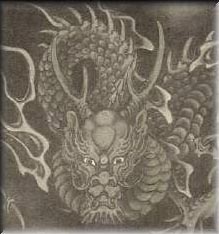
by Kawanabe Kyosai
~~ Book 1911160416 ~~
Paintings and Studies by Kawanabe Kyosai ~~
by Josiah Conder
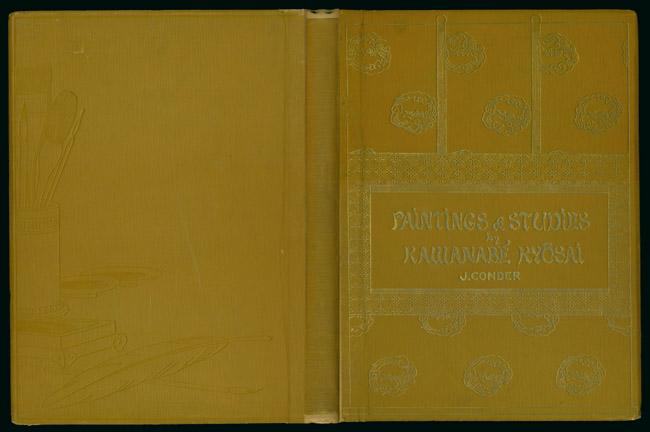
Condition. This book is in Very Good condition. It has been professionally restored utilizing the original boards and spine covering. The text block was previously severed from he original covers. It now has been re cased with new end papers added and the original spine relaided. The binding is now complete and solid. The gilt on the front cover is faded. There is very sporadic light to medium foxing. The title page has a foxed area and a few of the plates have scattered foxing. The text pages show light to moderate toning/aging. There are no tears or breaks to the pages and the text pages and all plates are free of markings. The book is absolutely complete with all text pages and plates.
Conder, Josiah
Tamura, T. (color frontispiece)
Ogawa, Kazumasa (collotype and halftone plates):
Paintings and Studies by Kawanabe Kyosai. An Illustrated and Descriptive Catalogue of a Collection of Paintings, Studies, and Sketches, by the Above Artist, with Explanatory Notes on the Principles, Materials, and Technique, of Japanese Painting, Tokyo, The Maruzen Kabushiki Kaisha, distributed by Kelly & Walsh, Ltd, printed by the "Japan Times" press, 1911, large 4to (11 x 14 1/2 in - 27.5 x 37 cm), green cloth with gilt decoration and lettering on front cover, beveled edges, I-XVII, 131 pp. Tissue guard protected "Illuminated" frontispiece in eighty color blocks and "heightened with gold and silver" by T. Tamura. Three plates of Kyosai seals and signatures printed in red (49 figures). Thirty-three collotype plates and twenty-two pages of half-tone illustrations (87 figures) by K. Ogawa. The 59 pages of plates [+1 (frontisplate) +3 (seal plates) +33 collotype plates +22 pages of halftone plates] are not numbered and are in addition to the 131 pages of text. Each of the 33 collotype plates is protected by a tissue guard with descriptive information.
This is a comprehensive catalogue of art by Kawanabe Kyosai that was in Josiah Conder's personal collection. The art is primarily from the period of 1881-1889. Conder was a student and personal friend of the artist. Through this large collection and his personal association with Kyosai, Conder was eminently qualified to discuss all aspects of the artist's work from material employed to methods and techniques of painting to how he signed his work.
Technical Aspects of Plates:
Frontisplate (1):
- Color wood block print.
- Printed one side only (faces title page).
- Thick paper stock - thickness measures 0.001in / 0.025mm.
- Tissue guard protected.
Collotype prints (33)
- Black and white collotype printed.
- Printed front side only.
- Thick paper stock - thickness measures 0.00125in / 0.031mm. .
- Descriptive text tissue guard protected.
Halftone prints (11 plates printed front and back, 22 pages with 87 numbered figures)
- Black and white halftone printed
- Printed front and back.
- Thin glossy paper stock - thickness measures 0.0006in / 0.015mm.
- No tissue guard protectors
Red prints (3 plate of Kyosai seals & signatures, 49 numbered figures).
- Red and white printed.
- Printed front side only.
- Thick paper stock - thickness measures 0.0008in / 0.02mm.
- No tissue guard protectors
Collotype Plates by K. Ogawa. The plates are numbered with Roman numerals. There are 33 collotype plates at the rear of the book and they are attributed to K. Ogawa on the title page. It is unclear whether he photographed them or actually printed the plates or both. This is generally the case in publications such as this and I suspect he photographed and printed them. These plates are on thick card stock type paper and printed on one side only. Each is protected by an unnumbered descriptive tissue guard and interspersed among these tissue guard protected plates are numbered pages with textual comment on the art depicted on the plates as well as art not depicted. While 33+ items are reproduced, there is commentary on 100+ items on these numbered text page. An illustrative numbered descriptive text page is here. These comments give a descriptive name for the item, the size, the medium painted on and the technique used. In addition, they indicate how the piece is signed with reference to the seals/signatures that are illustrated on 3 earlier pages. Plates are sometimes discussed and referenced in the earlier text portion of the book.
Here is how the collotype plates are organized.
Collection of Paintings (20 collotype plates, 82 items of art discussed
Screen Drawings (8 collotype plates, 12 items of art discussed)
Framed Paintings (5 collotype plates 6 items of art discussed)
Some plates present more than one item (like the screens where one plate has 2 or more images of panels from a screen). Likewise some text discussions cover more than one image).
Halftone Plates by K. Ogawa. There are 22 pages halftone plates (11 plates). These are printed on the same glossy paper which is the same weight as the text pages. The pages are printed front and back. Each image on the plate is assigned a figure number. There are a total of 87 figures. The figures are employed to illustrate points made in the text portion of the book.
The paintings and print subjects of Kawanabe Kyosai (1831-1889) range from traditional to comic, pornographic, bizarre and fantastic. His painting often contain imagery of dragons, ghosts, devils, and demons. His drawing style was unique and at the same time he was capable of painting in the finest traditional style. Kyosai formed a close association with Josiah Conder.
Contents
Page
Short Title Page I
Frontisplate II
Title Page III-IV
Preface V-X
Contents XI-XII
Errata Sheet bound in
List of illustrations XIII-XVII
Life of the Painter 1
Painting Materials 15
Painting Methods 27
Examples of Technique 45
Signatures and Seals 79
Catalogue of Collection 93
Glossary 127-131
Short-title page reads "Paintings and Studies by Kwanabe Kyosai".
Frontispiece: Chromo-xylograph of painting
on one leaf of Screen
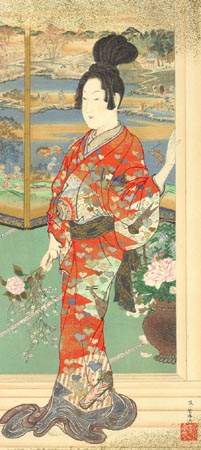 (Area of image is 12.2 x 27.1 cm)
Full Title Page (printed in red) is here
Collotype Plates
["Collection of Paintings" (Kakemono) heading, Plates I - XX]
Plate I. The famous courtesan, Jigokn-dayu, the priest Ikkiu,
and dancing skeletons.
(Area of image is 12.2 x 27.1 cm)
Full Title Page (printed in red) is here
Collotype Plates
["Collection of Paintings" (Kakemono) heading, Plates I - XX]
Plate I. The famous courtesan, Jigokn-dayu, the priest Ikkiu,
and dancing skeletons.
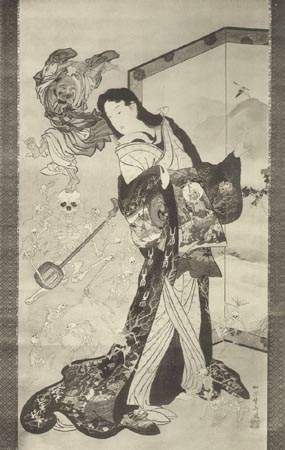 Plate II. Hut of the Chinese basket-maker Hokoji.
Hokoji's daughter Ueishojo.
Plate III. Paintings from Mitsunaga's scroll illustrating the
"Ills of Mankind"
A Ghost.
Plate II. Hut of the Chinese basket-maker Hokoji.
Hokoji's daughter Ueishojo.
Plate III. Paintings from Mitsunaga's scroll illustrating the
"Ills of Mankind"
A Ghost.
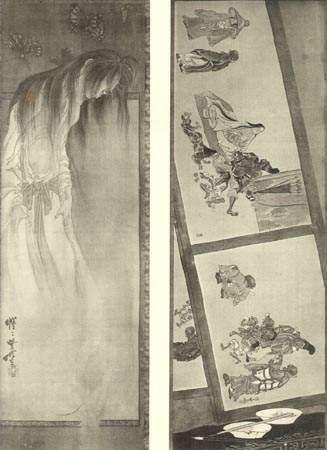 Plate IV. The Shinto deity Susano killing the nine-headed sea-dragon.
Plate V. The goddess Usume dancing.
The Wistaria-maiden and Demon-priest.
Plate IV. The Shinto deity Susano killing the nine-headed sea-dragon.
Plate V. The goddess Usume dancing.
The Wistaria-maiden and Demon-priest.
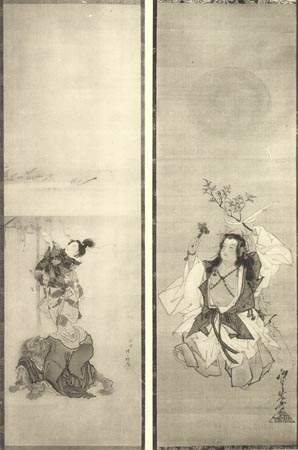 Plate VI. Ebisu and Okame before a painting of Daikolui.
Plate VII. The demon-queller (Shoki), and two demons.
Plate VI. Ebisu and Okame before a painting of Daikolui.
Plate VII. The demon-queller (Shoki), and two demons.
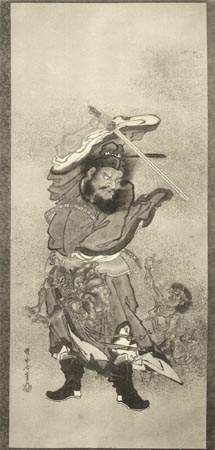 Plate VIII. Mountain view in rain.
Plate IX. Mushroom-gathering at Arashiyania.
Plate VIII. Mountain view in rain.
Plate IX. Mushroom-gathering at Arashiyania.
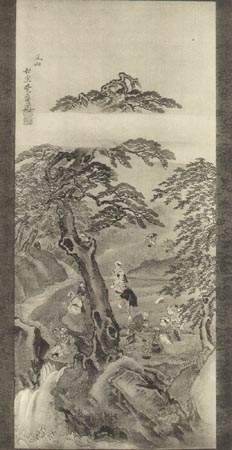 Plate X. A tiger.
Plate X. A tiger.
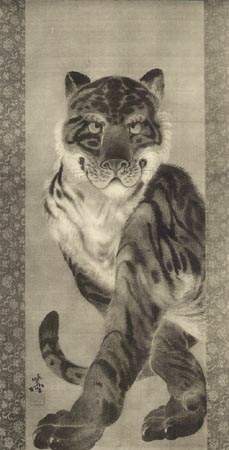 Plate with Description
Plate XI. The dragon crossing in front of Fujiyama.
Plate with Description
Plate XI. The dragon crossing in front of Fujiyama.
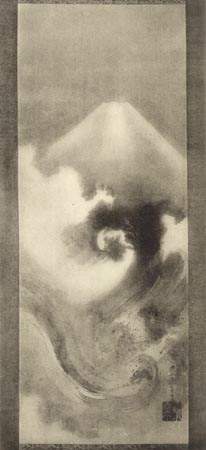 Plate XII. Bamboos in a rain storm.
Two crows on a tree, with landscape.
Plate XIII. Carp, swimming in a lake.
Plate XIV. A flying crane, pines, bamboos, and tortoises,
with the rising sun.
Plate XII. Bamboos in a rain storm.
Two crows on a tree, with landscape.
Plate XIII. Carp, swimming in a lake.
Plate XIV. A flying crane, pines, bamboos, and tortoises,
with the rising sun.
 Plate XV. The god-of-wind chased by a falcon.
Plate XVI. White eagle, and monkey.
Plate XVII. A concourse of crows.
Plate XVIII. The goddess Kwannon on a dragon.
Plate XV. The god-of-wind chased by a falcon.
Plate XVI. White eagle, and monkey.
Plate XVII. A concourse of crows.
Plate XVIII. The goddess Kwannon on a dragon.
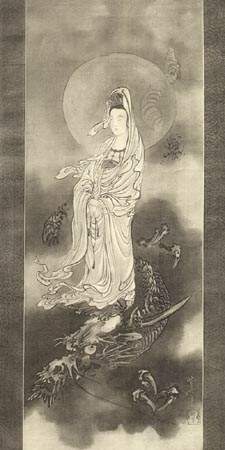 Plate XIX. The magician called Gama-Sennin.
The magician called Tekkai-Sennin.
Plate XX. A monkey. Hawk on snow-covered tree
holding a sparrow.
["Screens" Plates XXI - XXVIII]
Plale XXI. A Japanese beauty of the llth century. Female
Plate XIX. The magician called Gama-Sennin.
The magician called Tekkai-Sennin.
Plate XX. A monkey. Hawk on snow-covered tree
holding a sparrow.
["Screens" Plates XXI - XXVIII]
Plale XXI. A Japanese beauty of the llth century. Female
 attendant and young girl, of the same period.
Plate XXII. Hidari Jigoro and the Kyoto image.
Plate XXIII. Figure from the lyrical drama, Momiji-gari.
Sword and falling maple leaves.
Figures from the lyrical drama, representing the Thunder-god.
A priest struck by lightning.
Plate XXIV. The Kwannon temple of Kiyomidzu, with cherry trees in blossom.
The goddess Kwannon in battle.
attendant and young girl, of the same period.
Plate XXII. Hidari Jigoro and the Kyoto image.
Plate XXIII. Figure from the lyrical drama, Momiji-gari.
Sword and falling maple leaves.
Figures from the lyrical drama, representing the Thunder-god.
A priest struck by lightning.
Plate XXIV. The Kwannon temple of Kiyomidzu, with cherry trees in blossom.
The goddess Kwannon in battle.
 Plate XXV. The famous courtesan, Jigoku-dayu, in company with a demon.
The priest Ikkiu holding a skull on a stick.
Plate XXVI. A hawk in downward flight, and reeds.
A sparrow in flight and the rising sun.
A demon disguised as an itinerant priest, and a servant-hoy.
The Wistaria-maiden (Fujimusume) and a falconer emerging
from a painting on a screen.
Plate XXV. The famous courtesan, Jigoku-dayu, in company with a demon.
The priest Ikkiu holding a skull on a stick.
Plate XXVI. A hawk in downward flight, and reeds.
A sparrow in flight and the rising sun.
A demon disguised as an itinerant priest, and a servant-hoy.
The Wistaria-maiden (Fujimusume) and a falconer emerging
from a painting on a screen.
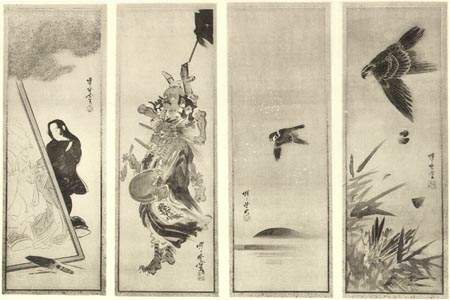 Plate XXVII. Small long-eared owl on a plum tree stump.
Fish of different kinds swimming.
White hawk, pine tree, and waterfall.
Plate XXVIII. Rabbits among flowers, and a snake.
A white and a black monkey on a fruit tree.
["Framed Paintings" (Gaku) Plates XXIX-XXXIII]
Plate XXIX. The seven gods of fortune and Okame at a banquet.
A procession of blind men led by a white hare to the moon.
Plato XXX. The dragon of Horiuji temple.
The female demon of Togakushi-yama.
Plate XXVII. Small long-eared owl on a plum tree stump.
Fish of different kinds swimming.
White hawk, pine tree, and waterfall.
Plate XXVIII. Rabbits among flowers, and a snake.
A white and a black monkey on a fruit tree.
["Framed Paintings" (Gaku) Plates XXIX-XXXIII]
Plate XXIX. The seven gods of fortune and Okame at a banquet.
A procession of blind men led by a white hare to the moon.
Plato XXX. The dragon of Horiuji temple.
The female demon of Togakushi-yama.
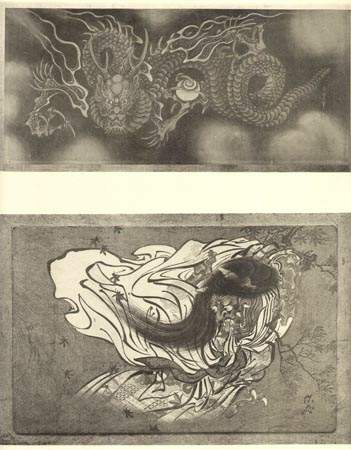 Plate XXXI. The temptation of Shaka Niorai.
Plate XXXI. The temptation of Shaka Niorai.
 Plate XXXII. The punishment and conversion of Rokuso Zenji.
Plate XXXII. The punishment and conversion of Rokuso Zenji.
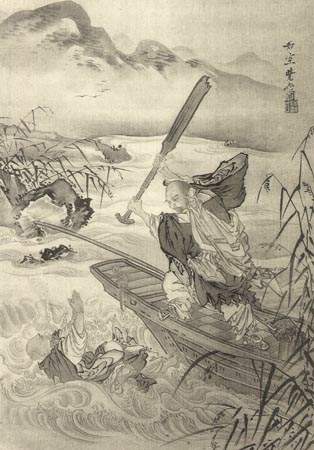 Plate XXXIII. Landscape showing a mountain tarn, with reeds, distant
hills, and a misty moor, with wild geese and ducks.
Half-tone Illustrations
Fig. 1. Diagram showing square brush-strokes used for drawing rocks
Fig. 2. Outlines for rocks and rushing torrent
Fig. 3. Outline of tree-structure
Fig. 4. Outlines of sea-rocks and waves
Fig. 5. Outline of tree in wind
Plate XXXIII. Landscape showing a mountain tarn, with reeds, distant
hills, and a misty moor, with wild geese and ducks.
Half-tone Illustrations
Fig. 1. Diagram showing square brush-strokes used for drawing rocks
Fig. 2. Outlines for rocks and rushing torrent
Fig. 3. Outline of tree-structure
Fig. 4. Outlines of sea-rocks and waves
Fig. 5. Outline of tree in wind
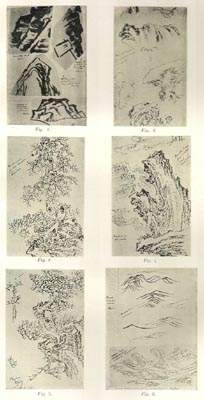 Fig. 6. Outlines of undulating water, and sketch in line of breakers,
made at Enoshima
Fig. 7. Diagram showing lines and washes used in drawing hill contours
Fig. 8. Outlines of nude figures in exaggerated action
Fig. 9. Various outlines used in representing different types of faces,
and hands
Fig. 10. Outlines employed in drawing drapery.
Fig. 11. Wash-sketches explanatory of drawing of small fish, of fish shown
in a water-current, and of the claw of a crab drawn in silhouette
Fig. 12. Sketches of carp made in outline and ink wash
Fig. 13. Study, in detailed outline, of two large carp made for painting
of Kakemono
Plate XIII
Fig. 14. Study in detailed outline of another carp as seen from the front,
for the same painting
Fig. 15. Study, in detailed outline, of back view of a carp, for the
same painting
Fig. 16. Outline study for the Kyoto image of the painting on Screen 3.
Plate XXII
Fig. 17. Outline study for the painting of a Chinese lady
Fig. 18. Outline drawing for album-painting of a tortoise catching a frog
Fig. 19. Outline study for the painting of Kwannon on a dragon in Kakemouo
Plate XVIII
Fig. 6. Outlines of undulating water, and sketch in line of breakers,
made at Enoshima
Fig. 7. Diagram showing lines and washes used in drawing hill contours
Fig. 8. Outlines of nude figures in exaggerated action
Fig. 9. Various outlines used in representing different types of faces,
and hands
Fig. 10. Outlines employed in drawing drapery.
Fig. 11. Wash-sketches explanatory of drawing of small fish, of fish shown
in a water-current, and of the claw of a crab drawn in silhouette
Fig. 12. Sketches of carp made in outline and ink wash
Fig. 13. Study, in detailed outline, of two large carp made for painting
of Kakemono
Plate XIII
Fig. 14. Study in detailed outline of another carp as seen from the front,
for the same painting
Fig. 15. Study, in detailed outline, of back view of a carp, for the
same painting
Fig. 16. Outline study for the Kyoto image of the painting on Screen 3.
Plate XXII
Fig. 17. Outline study for the painting of a Chinese lady
Fig. 18. Outline drawing for album-painting of a tortoise catching a frog
Fig. 19. Outline study for the painting of Kwannon on a dragon in Kakemouo
Plate XVIII
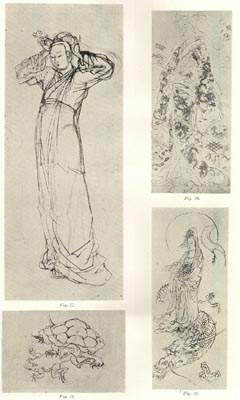 Fig. 20. Bold outline drawing of an actor
Fig. 21. Elaborate outline drawing for a painting of the goddess Usume
and musicians before the cave of the Sun-goddess
Fig. 22. Elaborate outline drawing for a painting of the god Tajikara hurling
away the cavern-rock and disclosing the Sun-goddess
Fig. 23. Outline drawing of a Rakan (Arhat) doctoring a dragon
Fig. 24. Outline drawing of three Rakan, an elephant, a camel, and a demon,
riding in the sea
Fig. 25. Ink line and wash drawing of a seated Rakan
Fig. 26. Ink outline drawing of a Rakan on a dragon, in waves
Fig. 27. Outline drawing of a Rakan, demon, and dragon
Fig. 28. Outline drawing of a Rakan with a lion
Fig. 29. Strong ink line drawing of a seated Rakan, rock, and owl
Fig. 30. Ink line and wash drawing of a Rakan playing with a monkey
Fig. 31. Ink line and wash drawing of a Rakan feasting, with attendant serving
Fig. 32. Unfinished outline of a Rakan with a crook, and another figure
Fig. 20. Bold outline drawing of an actor
Fig. 21. Elaborate outline drawing for a painting of the goddess Usume
and musicians before the cave of the Sun-goddess
Fig. 22. Elaborate outline drawing for a painting of the god Tajikara hurling
away the cavern-rock and disclosing the Sun-goddess
Fig. 23. Outline drawing of a Rakan (Arhat) doctoring a dragon
Fig. 24. Outline drawing of three Rakan, an elephant, a camel, and a demon,
riding in the sea
Fig. 25. Ink line and wash drawing of a seated Rakan
Fig. 26. Ink outline drawing of a Rakan on a dragon, in waves
Fig. 27. Outline drawing of a Rakan, demon, and dragon
Fig. 28. Outline drawing of a Rakan with a lion
Fig. 29. Strong ink line drawing of a seated Rakan, rock, and owl
Fig. 30. Ink line and wash drawing of a Rakan playing with a monkey
Fig. 31. Ink line and wash drawing of a Rakan feasting, with attendant serving
Fig. 32. Unfinished outline of a Rakan with a crook, and another figure
 faintly indicated in charcoal
Fig. 33. Outline study for the painting of Shoki and two demons in Kakemono 22,
Plate VII
Fig. 34. Humorous sketch in ink-wash of the God of thunder, fallen from
the clouds
Fig. 35. Humorous outline sketch of Ebisu with his fish
Fig. 36. Ink sketch of an aged man and a plant-seller
Fig. 37. Humorous outline sketches of Daikoku and Ebisu
Fig. 38. Ink sketch of a boy riding an ox, on a moor
Fig. 39. Illustration of the paintings of Screen 5
faintly indicated in charcoal
Fig. 33. Outline study for the painting of Shoki and two demons in Kakemono 22,
Plate VII
Fig. 34. Humorous sketch in ink-wash of the God of thunder, fallen from
the clouds
Fig. 35. Humorous outline sketch of Ebisu with his fish
Fig. 36. Ink sketch of an aged man and a plant-seller
Fig. 37. Humorous outline sketches of Daikoku and Ebisu
Fig. 38. Ink sketch of a boy riding an ox, on a moor
Fig. 39. Illustration of the paintings of Screen 5
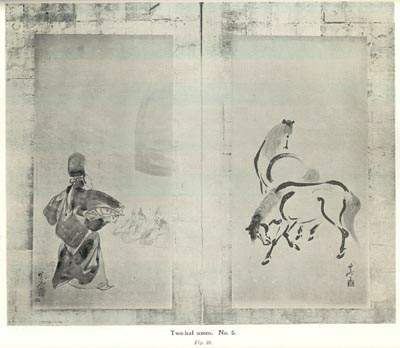 Fig. 40. Rough design for ornament used on robe of figure in Screen 1,
Frontispiece, and Plate XXI
Fig. 41. Rough design for water-spirals and ballast-baskets in the
same painting
Fig. 42. Diagram for setting-onto of bamboo pattern on the same painting
Fig. 43. Sketch in ink of the same bamboo-pattern
Fig. 44. Design for medallions used on the sash of figure in the same painting
Fig. 45. Designs for other medallions
Fig. 46. Design for ornament of wave-spirals
Fig. 47. Design for sea-weed ornament
Fig. 48. Design for painted dragon on drum
Fig. 49. Study for distribution of ivy-leaf pattern upon robe of
figure in Screen 1
Fig. 50. Detailed outline study for wicker-work flower-basket in
the same painting
Fig. 51. Continuation of Fig. 49
Fig. 40. Rough design for ornament used on robe of figure in Screen 1,
Frontispiece, and Plate XXI
Fig. 41. Rough design for water-spirals and ballast-baskets in the
same painting
Fig. 42. Diagram for setting-onto of bamboo pattern on the same painting
Fig. 43. Sketch in ink of the same bamboo-pattern
Fig. 44. Design for medallions used on the sash of figure in the same painting
Fig. 45. Designs for other medallions
Fig. 46. Design for ornament of wave-spirals
Fig. 47. Design for sea-weed ornament
Fig. 48. Design for painted dragon on drum
Fig. 49. Study for distribution of ivy-leaf pattern upon robe of
figure in Screen 1
Fig. 50. Detailed outline study for wicker-work flower-basket in
the same painting
Fig. 51. Continuation of Fig. 49
 Fig. 52. Ink sketches for two horizontal panel paintings of crows
Fig. 53. Ink sketches for two horizontal panel paintings of crows
Fig. 54. Ink sketches for two horizontal panel paintings of crows
Fig. 55. Ink sketches for two horizontal panel paintings of crows
Fig. 56. Ink sketches for two horizontal panel paintings of crows
Fig. 57. Ink sketches for two horizontal panel paintings of crows
Fig. 58. Ink sketches for two horizontal panel paintings of crows
Fig. 59. Ink sketches for two horizontal panel paintings of crows
Fig. 52. Ink sketches for two horizontal panel paintings of crows
Fig. 53. Ink sketches for two horizontal panel paintings of crows
Fig. 54. Ink sketches for two horizontal panel paintings of crows
Fig. 55. Ink sketches for two horizontal panel paintings of crows
Fig. 56. Ink sketches for two horizontal panel paintings of crows
Fig. 57. Ink sketches for two horizontal panel paintings of crows
Fig. 58. Ink sketches for two horizontal panel paintings of crows
Fig. 59. Ink sketches for two horizontal panel paintings of crows
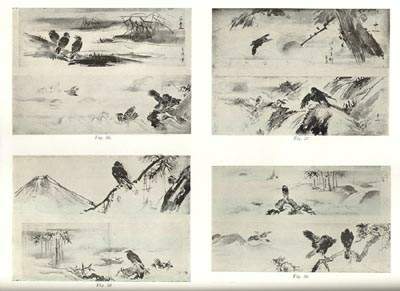 Fig. 60. Outline sketch for horizontal panel painting of crows
Fig. 61. Ink sketch for horizontal panel painting of pigeons in
bamboos
Fig. 62. Outline study of pigeons and clouds
Fig. 63. Ink sketch for vertical panel painting of crows
Fig. 64. Ink sketch for vertical panel painting of crows
Fig. 65. Ink sketch for vertical panel painting of small birds
Fig. 66. Ink sketch for vertical panel painting of crows and sun
Fig. 67. Ink-wash sketch of ladies and children at games
Fig. 68. Rough ink sketches for panel pictures of long-armed monkeys
Fig. 69. Ink-wash sketch of dancing figures
Fig. 60. Outline sketch for horizontal panel painting of crows
Fig. 61. Ink sketch for horizontal panel painting of pigeons in
bamboos
Fig. 62. Outline study of pigeons and clouds
Fig. 63. Ink sketch for vertical panel painting of crows
Fig. 64. Ink sketch for vertical panel painting of crows
Fig. 65. Ink sketch for vertical panel painting of small birds
Fig. 66. Ink sketch for vertical panel painting of crows and sun
Fig. 67. Ink-wash sketch of ladies and children at games
Fig. 68. Rough ink sketches for panel pictures of long-armed monkeys
Fig. 69. Ink-wash sketch of dancing figures
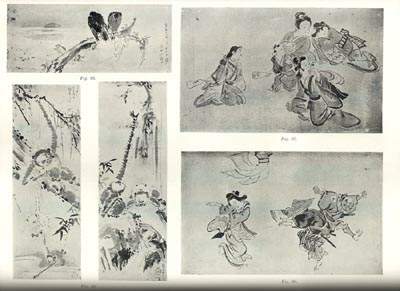 Fig. 70. Ink-wash sketch of Okame, Daikoku, and his rats
Fig. 71. Ink line sketch of Hotei and children
Fig. 72. Ink-wash sketch of Daikoku and Ebisu
Fig. 73. Outline sketch of Daikoku with rats, and Fukurokujin
with children
Fig. 74. Outline sketches of Daikoku as a pedlar
Fig. 75. Rough outline sketch of subject from history of Yoshitsune
Fig. 76. Rough outline sketch of numerous figures carousing
Fig. 77. Sundry rough outline sketches
Fig. 78. Rough outline sketch of numerous figures at amusements
Fig. 70. Ink-wash sketch of Okame, Daikoku, and his rats
Fig. 71. Ink line sketch of Hotei and children
Fig. 72. Ink-wash sketch of Daikoku and Ebisu
Fig. 73. Outline sketch of Daikoku with rats, and Fukurokujin
with children
Fig. 74. Outline sketches of Daikoku as a pedlar
Fig. 75. Rough outline sketch of subject from history of Yoshitsune
Fig. 76. Rough outline sketch of numerous figures carousing
Fig. 77. Sundry rough outline sketches
Fig. 78. Rough outline sketch of numerous figures at amusements
 Fig. 79. Illustration of Daruma painting, Kakemono 68
Fig. 79. Illustration of Daruma painting, Kakemono 68
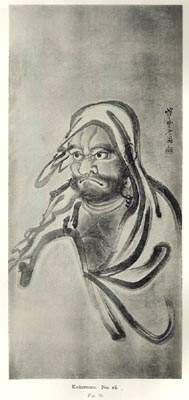 Fig. 80. Illustration of large Daruma painting, unmounted Kakemono 79
Fig. 81. Outline sketch of youth flying a kite
Fig. 82. Outline sketch of female figures dancing
Fig 83. Outline sketch of a Shinto dance
Fig. 84. Caricature sketch in outline
Fig. 85. Outline copy of carved image by Unkei, at Kamakura
Fig. 86. Caricature sketch of Shoki, demons, and Emma-o
Fig. 80. Illustration of large Daruma painting, unmounted Kakemono 79
Fig. 81. Outline sketch of youth flying a kite
Fig. 82. Outline sketch of female figures dancing
Fig 83. Outline sketch of a Shinto dance
Fig. 84. Caricature sketch in outline
Fig. 85. Outline copy of carved image by Unkei, at Kamakura
Fig. 86. Caricature sketch of Shoki, demons, and Emma-o
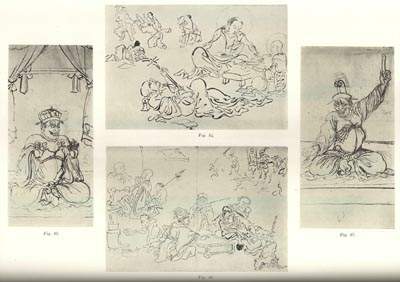 Fig. 87. Outline copy of carved image by Unkei, at Kamakura
Impressions in red of 16 of Kyosai's seals
Fig. 87. Outline copy of carved image by Unkei, at Kamakura
Impressions in red of 16 of Kyosai's seals
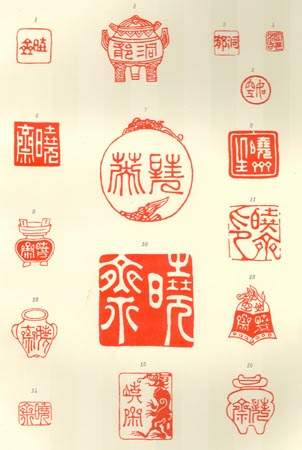 Impressions in red of 18 of Kyosai's seals
Impressions in red of 18 of Kyosai's seals
 Impressions in red of 15 of Kyosai's seals
Impressions in red of 15 of Kyosai's seals

Close up of the high quality K. Ogawa collotype printing

From Plate III
|




























 Impressions in red of 18 of Kyosai's seals
Impressions in red of 18 of Kyosai's seals
 Impressions in red of 15 of Kyosai's seals
Impressions in red of 15 of Kyosai's seals

